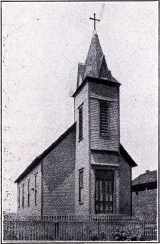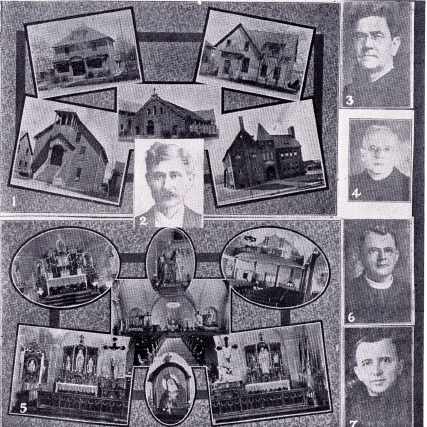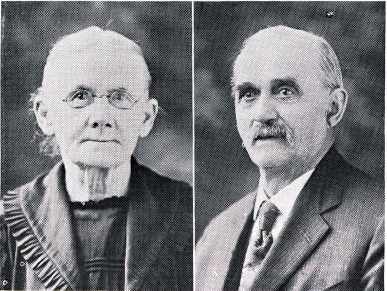NEGenWeb Project
Church/Catholic
Franciscans
Chapter XXVII
St. Francis Church, South Omaha
While Immaculate Conception parish for the Poles in Sheely began to flourish under the prudent and energetic direction of Rev. Theobald Kalamaja, many Poles began to settle in South Omaha in the vicinity of the stockyards, where they found employment. Mr. Albert Barouch was among the first to establish his residence in South Omaha. Between 1884-1890 there were few Poles living there. Gradually the packing houses attracted many Poles from Chicago and other places, eventually even from Europe. They settled mostly in Sheely far from their place of work, in order to be near the Polish church. In 1894 there were twenty-five Polish families and in 1898 about thirty-five Polish families and a score of single men in South Omaha attending St. Mary's while living chiefly north of the packing houses.
ORGANIZING ST. FRANCIS' PARISH
REV. DENNIS CZECH, O, F. M.,
FIRST PASTOR
Seeing the steady influx of his countrymen to South Omaha, Fr. Theobald Kalamaja, O, F. M., pastor of Immaculate Conception parish, after obtaining permission from his Bishop and the Provincial, in summer 1898, called a mass meeting of the Poles, which was attended by Joseph and Stanislaus Waurzynkiewiecz, Jacob Baister, M. Helmach, A. Niedjielski, J. Badura, Mr. Szymanski, Mr. Karbowski, and Mr. Cera. They drew up a resolution to organize a Polish parish in South Omaha. The other Polish families held back mistrusting the venture. In summer, 1898, a lot with a building that had served as a Methodist or Baptist meeting-house, located on 33rd Street between J and K Streets, was purchased for the sum of $750. The building measured 24x46 feet, the inside was unfinished and much labor and expense were needed to remodel it into a Catholic church. As about half the Polish families refused their cooperation, the other half had no easy sailing. Yet warm hearts and willing hands directed by the untiring and self-sacrificing Father Theobald, realized their hopes. In the winter following (in 1898) they enjoyed, every second week, the happiness of Holy Mass in their own place of worship. On May 15, 1899, the church was dedicated by the Rt. Rev. R. Bishop Scannell, D. D., and named St. Francis de Paula, after the patron saint of the men's society in the mother parish, of which society some men of South Omaha were members. Beginning with July, 1899, St. Francis received Divine Service every Sunday, the Rev. Dennis Czech, O, F. M., having been appointed the first permanent pastor. All the Polish people of South Omaha belonged to the new parish; a few only, living nearer the confines of the two parishes and having easier access to St. Mary's retained membership there.
The frail "Little Father" labored very zealously and successfully. He organized a choir, Mr. Buglewisz being the organist, and helped along practising (sic) by accompanying the singing on the violin. The services, two Masses, were found necessary and were well arranged and well attended. During the fourteen months of Fr. Dennis' rectorship his efforts and the people's generosity wiped out all indebtedness, paid the current expenses and laid the foundation for a school fund. The people much regretted the transfer of the popular "Little Father" to Wash-
551
![]()
ington, Missouri, in September, 1900. His successor was the Rev. Menander Jaroscewicz, O, F. M.
REV. MENANDER JAROSCEWICZ, O, F. M.,
(1900-JULY, 1903)
In May, 1901, St. Francis' parish enjoyed the blessing of a holy mission preached by Rev. Remy Berent, O, F. M. It was very well attended.
The only lot owned by St. Francis' church was surrounded by cottages and a public school. A parochial school for the children of 100 families and an office for the pastor were urgent needs. Accordingly, with the advice and consent of the

First Church of St. Francis, South Omaha.
Rt. Rev. Ordinary of the diocese, a new site was purchased in summer of 1901. It comprised lots 9, 10, 11 and 12 of Block 346, i. e., on the east side of 32nd Street, between J and K Streets. The corner adjoining these was very desirable, but the Rev. P. McDonald would not sell it. To this new site the church building was moved in the following year, 1902. About this time the handsome altar was presented to St. Francis' church by the Sisters of St. Joseph's Hospital.
As there was not yet any school or pastoral residence, the priest had his office in a private home, mostly at the Baister residence. It was hard to decide which of the two requisite buildings should be erected first. The pastor preferred the less expensive building and began to excavate sufficient room under church, intending to establish his office there. Before completing his plan he was transferred to Radom, Ill., soon suffered there a stroke of paralysis and remained an invalid to the day of his death on July 18, 1907, at Teutopolis. Death occurred to Fr. Menander in the 48th year of his age, the 16th of his profession and the 12th of his priesthood.
Fr. M. Gregory Jaroscewics was a native of Samotschin, Posen, Germany (now Poland). His birth occurred March 12, 1860. He came to the United States and labored as a carpenter. Feeling a belated vocation to the priesthood in' the religious state, he made his classical studies at Teutopolis, entered the Order of Friars Minor on-----, 18--, took his simple vows ----, 18--, and was ordained priest. After being in charge of the parish in Clover Bottom, near Washington, Missouri, he came to Omaha .--R. I. P.
His successor at Omaha was the Rev. Cyril Mitera, O, F. M.
REV. CYRIL MITERA, O, F. M.,
JULY 20, 1902-1906
The plans of his predecessor were changed. In a meeting held in August of 1902, Father Theobald and the pastor explained a plan for a two-story building, 40x70 feet, the upper story to serve as a church, the lower to contain three class rooms and two rooms for the pastor when at the church. For he had his residence proper at St. Joseph's friary, 16th and Center Streets. The contract was let September 5, 1902. The structure cost $5,000.00 without the porches and front improvements added later. This building was dedicated Sunday, December 7, 1902, after High Mass celebrated by Father Theobald, by the Rt. Rev. Bishop. The celebrant preached in Polish while his Lordship spoke in English.
THE PAROCHIAL SCHOOL
The Parochial School was opened in February, 1903. It was impossible to get any Sisters in the middle of the school year. Mr. Stanislaus Gazinski, and after him a young lady, Miss Theophila Findler, taugh (sic) the school until June, 1903. About fifty children were enrolled as pupils. As the Franciscan Sisters of Lafayette, Indiana, promised to furnish two teachers, the old church was remodelled (sic) into a convent. A new floor was put in, the whole plastered anew and furnished at an outlay of $2,000. This gave the parish six commodious rooms in the first story, three in the second, a laundry and cellar underneath.
On September 8, 1903, the Ven. Sisters opened two class rooms with sixty-five pupils, which number was almost doubled before the end of the year. In 1904-1905 a third teacher became necessary for the 150 children frequenting the school. To support St. Francis' school the parents pay 50 cents tuition for one child, $1.00 for two or more children. From the indigent no tuition was demanded. Yes, they were furnished with school books gratis.
552
![]()
The income of the church consisted mainly in pew rent and monthly collections. No fairs or socials were ever held till 1905.
The building program of 1903 incurred an indebtedness of $3,000. This could have been easily liquidated within two years but for the many and constant improvements made and the strike in the packing houses, July to September, 1904. In June, 1905, the indebtedness had been reduced to $1,500.00.
IMPROVEMENTS
Handsome desks were provided for 210 pupils, two new side altars ($500) including four statues, also communion rail ($140) and a baptismal font were procured. The corner lot with five buildings (an intolerable nuisance), was purchased in August, 1905, through Mr. Franck. The houses were removed and $1,100 paid for the vacant lot, 69x130 feet in Block 346, No. 8, corner 32nd and K Streets. The deed is dated September 14, 1905, and is in the name of the Rt. Rev. Richard Scannell, Bishop of Omaha.

St. Francis Church, South Omaha: (1) Various Buildings; (2) Mr. Jos. Wawrzynkiewicz, Founder of the Parish; (3) Rev. Theobald Kalamaja, O, F. M.; (5) Interior of St. Francis's Church; (6) Rev. Rembert Stanowski, O, F. M.; (7) Rev. Cyril Mitera, O, F. M.
STATUS OF PARISH IN 1905
In 1905 the parish numbered about 170 Polish families and a few hundred single men. There were also about thirty-five Lithuanian families and some scores of young men in South Omaha, who understood Polish and attended chiefly St. Francis' church without becoming permanent parishioners, as they were considering the establishment at some later day of a Lithuanian church with a Lithuanian as pastor. Up to this time there were no mixed marriages and only about six children attending the public school, the children of parents who were poor church-goers. The parishioners, according to the testimony of their pastor, were industrious, frugal and, in general, well devoted to their faith and their church.
A mission was given in November, 1905, by some Jesuit Fathers.
After the departure of Rev. Cyril Mitera for Columbus, Nebraska, in 1906, he was succeeded
553
![]()
by the Rev. Ladislaus Czech, O, F. M., 1906-July, 1907.
Rev. Rembert Stanowski, O, F. M., took charge in July, 1907, and was the last Franciscan pastor until the parish was turned over to the diocese about May 20, 1910, when the Rev. Michael Gluba, the present pastor, took charge.
ERECTION OF NEW CHURCH
When the cornerstone arrived for the new church some Poles noticed that the inscription had been carved in English. Immediately strong protests were raised. Father Rembert excused himself that it was only one or the other day before the day on which the cornerstone was to be laid and too late to change the inscription now. In vain. To appease the opposition, he promised to turn the uncarved side out and have the inscription carved after the ceremony. But during the festive occasion, in August, 1909, the Rt: Bishop laid the cornerstone correctly and the incident was forgotten in the joy of the occasion. On this occasion, two large bells were blessed by the Rt. Rev. Richard Scannell.
DEDICATION OF THE CHURCH
The church, 60x135 feet in dimensions, and furnished with new pews, altar railing, pulpit, and a pipe organ, was dedicated December 12, 1909.
N.B.: When a new church was erected on a new site in 1903, the name of the church was changed by permission of the Rt. Rev. Bishop and the Roman Congregation (through the efforts of the Very Rev. Provincial and the Very Rev. Procurator General) into that of St. Francis of Assissi (sic) (sic), our holy founder-mainly because the faithful ill instructed considered him as the patron of their church, the other Saint Francis being little known.

Mr. and Mrs. Joseph Van Ackeren, Humphrey, Neb.
554
![]()
|
|||